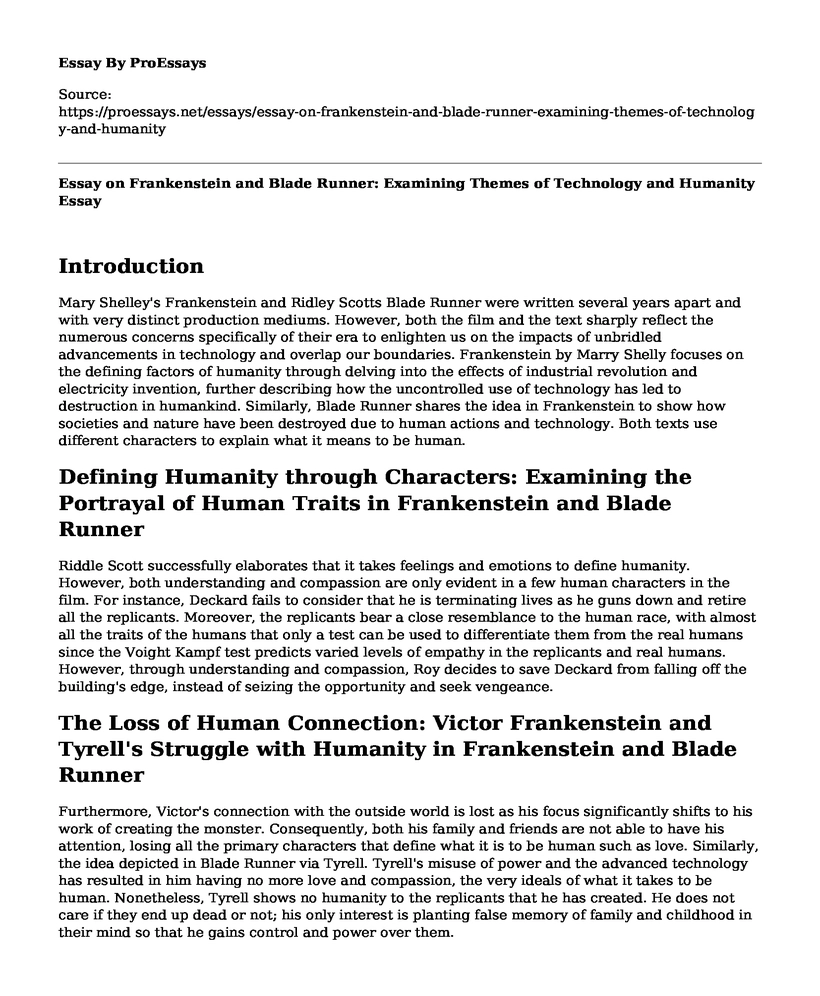Introduction
Mary Shelley's Frankenstein and Ridley Scotts Blade Runner were written several years apart and with very distinct production mediums. However, both the film and the text sharply reflect the numerous concerns specifically of their era to enlighten us on the impacts of unbridled advancements in technology and overlap our boundaries. Frankenstein by Marry Shelly focuses on the defining factors of humanity through delving into the effects of industrial revolution and electricity invention, further describing how the uncontrolled use of technology has led to destruction in humankind. Similarly, Blade Runner shares the idea in Frankenstein to show how societies and nature have been destroyed due to human actions and technology. Both texts use different characters to explain what it means to be human.
Defining Humanity through Characters: Examining the Portrayal of Human Traits in Frankenstein and Blade Runner
Riddle Scott successfully elaborates that it takes feelings and emotions to define humanity. However, both understanding and compassion are only evident in a few human characters in the film. For instance, Deckard fails to consider that he is terminating lives as he guns down and retire all the replicants. Moreover, the replicants bear a close resemblance to the human race, with almost all the traits of the humans that only a test can be used to differentiate them from the real humans since the Voight Kampf test predicts varied levels of empathy in the replicants and real humans. However, through understanding and compassion, Roy decides to save Deckard from falling off the building's edge, instead of seizing the opportunity and seek vengeance.
The Loss of Human Connection: Victor Frankenstein and Tyrell's Struggle with Humanity in Frankenstein and Blade Runner
Furthermore, Victor's connection with the outside world is lost as his focus significantly shifts to his work of creating the monster. Consequently, both his family and friends are not able to have his attention, losing all the primary characters that define what it is to be human such as love. Similarly, the idea depicted in Blade Runner via Tyrell. Tyrell's misuse of power and the advanced technology has resulted in him having no more love and compassion, the very ideals of what it takes to be human. Nonetheless, Tyrell shows no humanity to the replicants that he has created. He does not care if they end up dead or not; his only interest is planting false memory of family and childhood in their mind so that he gains control and power over them.
Nature and Society: The Devastating Effects of Uncontrolled Technological Progress in Frankenstein and Blade Runner
Moreover, both Victor and Tyrell creat life, this concept is heavily used by Scott and Shelley to question society's view on humanity. For instance, in Frankenstein, the monster is portrayed as intelligent, kind, and educated. The monster displays a high sense of sympathy and compassion through assisting De lacey undertake their house chores and helping the girl from drowning in the river. However, the monster is not appreciated, and society shows him no sympathy because of how he looks. Similarly, in Blade Runner the creation of the replicants is so perfect and close to the human race, it takes a Voight Kampf test to distinguish between the replicants and humans.
Conclusion
In conclusion, Scott uses the Blade Runner characters and setting to draw the definition of being human; Scot comments about nothing natural existing in the world since the failure of humans to observe humanity has led to both life and nature being destroyed. Similarly, Shelley applies Romantic's perception of scientific advancements to explain how society and nature have been damaged through the creation of the monster. It is ironic that instead of human connecting with nature, the monster does, yet he is a non-human character. Moreover, the two texts significantly reflect on how society has lost the vital defining concepts of humanity, such as humanity, love, understanding, and compassion.
Works Cited
Scott, Ridley, et al. Blade runner. Los Angeles: Warner Home Video, 1982.
Shelley, Mary. Frankenstein. Broadview Press, 2012.
Cite this page
Essay on Frankenstein and Blade Runner: Examining Themes of Technology and Humanity. (2023, Jun 06). Retrieved from https://proessays.net/essays/essay-on-frankenstein-and-blade-runner-examining-themes-of-technology-and-humanity
If you are the original author of this essay and no longer wish to have it published on the ProEssays website, please click below to request its removal:
- Poetry Analysis Essay on "Do Not Go Into That Good Night"
- Torvald's View of His Wife and "A Woman's Place" - Critical Essay
- Macbeth and Lady Macbeth Relationship Essay
- Essay Example on Greeks and Their Gods: A Special Relationship
- Agamemnon & Achilles: Epic Heroes in Homer's Iliad - Essay Sample
- Essay Example on Neverhome: Exploring Power Through Dispositional Characteristics
- Sir Thomas Wyatt's Love Poems: Heartache & Loyalty - Essay Sample







